Management and Operations Report
VerifiedAdded on 2020/12/30
|18
|5278
|70
Report
AI Summary
This report analyzes the roles of leaders and managers in Toyota, a multinational automotive company. It explores different leadership and management theories, examines key operational functions, and discusses the impact of external business environment factors on decision-making. The report also provides recommendations for improving operational efficiency.
Contribute Materials
Your contribution can guide someone’s learning journey. Share your
documents today.
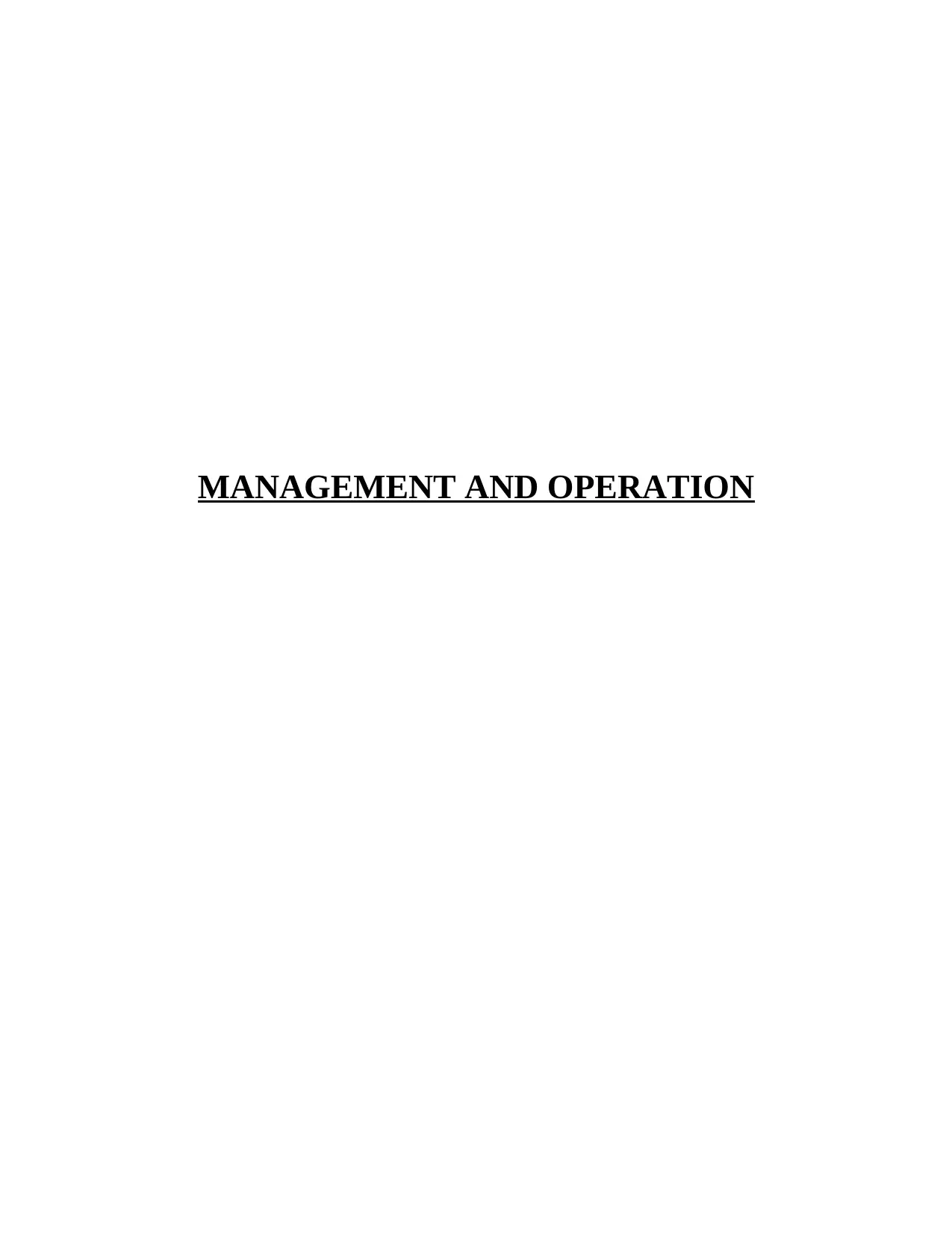
MANAGEMENT AND OPERATION
Secure Best Marks with AI Grader
Need help grading? Try our AI Grader for instant feedback on your assignments.

Table of Contents
INTRODUCTION...........................................................................................................................1
TASK-1............................................................................................................................................1
P1. Define and compare the different roles nad characteristic of leader and management....1
P2. Different roles of management and leadership in different organisational situation ......4
P3 different approaches of leadership and management .......................................................5
P4 . Key operations of Toyota ...............................................................................................7
P5 Importance and value of operational management...........................................................9
P6. Impact of external business environment factors that can affect the decision-making
process of the leader and manager .......................................................................................11
CONCLUSION..............................................................................................................................13
REFERENCES..............................................................................................................................15
INTRODUCTION...........................................................................................................................1
TASK-1............................................................................................................................................1
P1. Define and compare the different roles nad characteristic of leader and management....1
P2. Different roles of management and leadership in different organisational situation ......4
P3 different approaches of leadership and management .......................................................5
P4 . Key operations of Toyota ...............................................................................................7
P5 Importance and value of operational management...........................................................9
P6. Impact of external business environment factors that can affect the decision-making
process of the leader and manager .......................................................................................11
CONCLUSION..............................................................................................................................13
REFERENCES..............................................................................................................................15
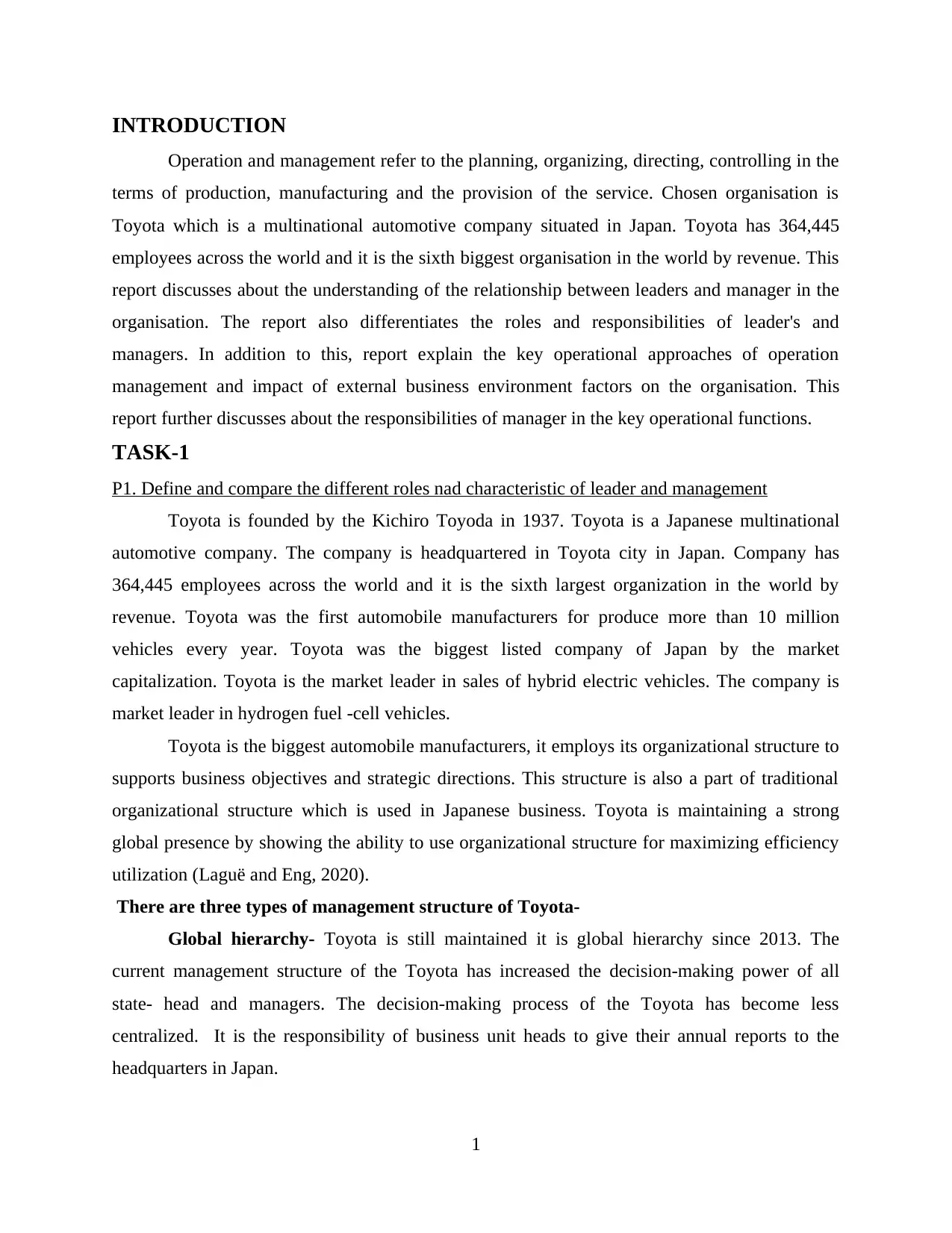
INTRODUCTION
Operation and management refer to the planning, organizing, directing, controlling in the
terms of production, manufacturing and the provision of the service. Chosen organisation is
Toyota which is a multinational automotive company situated in Japan. Toyota has 364,445
employees across the world and it is the sixth biggest organisation in the world by revenue. This
report discusses about the understanding of the relationship between leaders and manager in the
organisation. The report also differentiates the roles and responsibilities of leader's and
managers. In addition to this, report explain the key operational approaches of operation
management and impact of external business environment factors on the organisation. This
report further discusses about the responsibilities of manager in the key operational functions.
TASK-1
P1. Define and compare the different roles nad characteristic of leader and management
Toyota is founded by the Kichiro Toyoda in 1937. Toyota is a Japanese multinational
automotive company. The company is headquartered in Toyota city in Japan. Company has
364,445 employees across the world and it is the sixth largest organization in the world by
revenue. Toyota was the first automobile manufacturers for produce more than 10 million
vehicles every year. Toyota was the biggest listed company of Japan by the market
capitalization. Toyota is the market leader in sales of hybrid electric vehicles. The company is
market leader in hydrogen fuel -cell vehicles.
Toyota is the biggest automobile manufacturers, it employs its organizational structure to
supports business objectives and strategic directions. This structure is also a part of traditional
organizational structure which is used in Japanese business. Toyota is maintaining a strong
global presence by showing the ability to use organizational structure for maximizing efficiency
utilization (Laguë and Eng, 2020).
There are three types of management structure of Toyota-
Global hierarchy- Toyota is still maintained it is global hierarchy since 2013. The
current management structure of the Toyota has increased the decision-making power of all
state- head and managers. The decision-making process of the Toyota has become less
centralized. It is the responsibility of business unit heads to give their annual reports to the
headquarters in Japan.
1
Operation and management refer to the planning, organizing, directing, controlling in the
terms of production, manufacturing and the provision of the service. Chosen organisation is
Toyota which is a multinational automotive company situated in Japan. Toyota has 364,445
employees across the world and it is the sixth biggest organisation in the world by revenue. This
report discusses about the understanding of the relationship between leaders and manager in the
organisation. The report also differentiates the roles and responsibilities of leader's and
managers. In addition to this, report explain the key operational approaches of operation
management and impact of external business environment factors on the organisation. This
report further discusses about the responsibilities of manager in the key operational functions.
TASK-1
P1. Define and compare the different roles nad characteristic of leader and management
Toyota is founded by the Kichiro Toyoda in 1937. Toyota is a Japanese multinational
automotive company. The company is headquartered in Toyota city in Japan. Company has
364,445 employees across the world and it is the sixth largest organization in the world by
revenue. Toyota was the first automobile manufacturers for produce more than 10 million
vehicles every year. Toyota was the biggest listed company of Japan by the market
capitalization. Toyota is the market leader in sales of hybrid electric vehicles. The company is
market leader in hydrogen fuel -cell vehicles.
Toyota is the biggest automobile manufacturers, it employs its organizational structure to
supports business objectives and strategic directions. This structure is also a part of traditional
organizational structure which is used in Japanese business. Toyota is maintaining a strong
global presence by showing the ability to use organizational structure for maximizing efficiency
utilization (Laguë and Eng, 2020).
There are three types of management structure of Toyota-
Global hierarchy- Toyota is still maintained it is global hierarchy since 2013. The
current management structure of the Toyota has increased the decision-making power of all
state- head and managers. The decision-making process of the Toyota has become less
centralized. It is the responsibility of business unit heads to give their annual reports to the
headquarters in Japan.
1
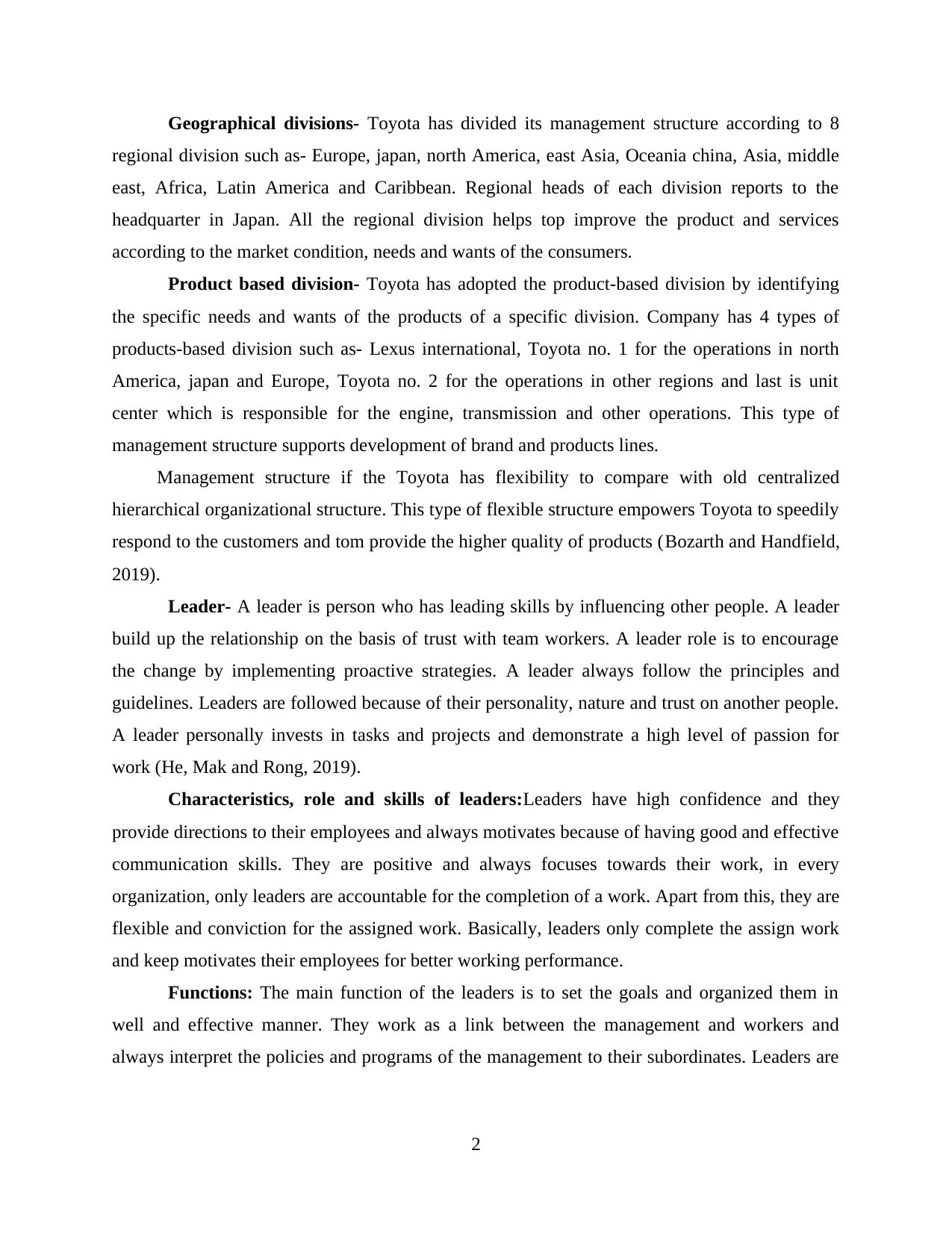
Geographical divisions- Toyota has divided its management structure according to 8
regional division such as- Europe, japan, north America, east Asia, Oceania china, Asia, middle
east, Africa, Latin America and Caribbean. Regional heads of each division reports to the
headquarter in Japan. All the regional division helps top improve the product and services
according to the market condition, needs and wants of the consumers.
Product based division- Toyota has adopted the product-based division by identifying
the specific needs and wants of the products of a specific division. Company has 4 types of
products-based division such as- Lexus international, Toyota no. 1 for the operations in north
America, japan and Europe, Toyota no. 2 for the operations in other regions and last is unit
center which is responsible for the engine, transmission and other operations. This type of
management structure supports development of brand and products lines.
Management structure if the Toyota has flexibility to compare with old centralized
hierarchical organizational structure. This type of flexible structure empowers Toyota to speedily
respond to the customers and tom provide the higher quality of products (Bozarth and Handfield,
2019).
Leader- A leader is person who has leading skills by influencing other people. A leader
build up the relationship on the basis of trust with team workers. A leader role is to encourage
the change by implementing proactive strategies. A leader always follow the principles and
guidelines. Leaders are followed because of their personality, nature and trust on another people.
A leader personally invests in tasks and projects and demonstrate a high level of passion for
work (He, Mak and Rong, 2019).
Characteristics, role and skills of leaders:Leaders have high confidence and they
provide directions to their employees and always motivates because of having good and effective
communication skills. They are positive and always focuses towards their work, in every
organization, only leaders are accountable for the completion of a work. Apart from this, they are
flexible and conviction for the assigned work. Basically, leaders only complete the assign work
and keep motivates their employees for better working performance.
Functions: The main function of the leaders is to set the goals and organized them in
well and effective manner. They work as a link between the management and workers and
always interpret the policies and programs of the management to their subordinates. Leaders are
2
regional division such as- Europe, japan, north America, east Asia, Oceania china, Asia, middle
east, Africa, Latin America and Caribbean. Regional heads of each division reports to the
headquarter in Japan. All the regional division helps top improve the product and services
according to the market condition, needs and wants of the consumers.
Product based division- Toyota has adopted the product-based division by identifying
the specific needs and wants of the products of a specific division. Company has 4 types of
products-based division such as- Lexus international, Toyota no. 1 for the operations in north
America, japan and Europe, Toyota no. 2 for the operations in other regions and last is unit
center which is responsible for the engine, transmission and other operations. This type of
management structure supports development of brand and products lines.
Management structure if the Toyota has flexibility to compare with old centralized
hierarchical organizational structure. This type of flexible structure empowers Toyota to speedily
respond to the customers and tom provide the higher quality of products (Bozarth and Handfield,
2019).
Leader- A leader is person who has leading skills by influencing other people. A leader
build up the relationship on the basis of trust with team workers. A leader role is to encourage
the change by implementing proactive strategies. A leader always follow the principles and
guidelines. Leaders are followed because of their personality, nature and trust on another people.
A leader personally invests in tasks and projects and demonstrate a high level of passion for
work (He, Mak and Rong, 2019).
Characteristics, role and skills of leaders:Leaders have high confidence and they
provide directions to their employees and always motivates because of having good and effective
communication skills. They are positive and always focuses towards their work, in every
organization, only leaders are accountable for the completion of a work. Apart from this, they are
flexible and conviction for the assigned work. Basically, leaders only complete the assign work
and keep motivates their employees for better working performance.
Functions: The main function of the leaders is to set the goals and organized them in
well and effective manner. They work as a link between the management and workers and
always interpret the policies and programs of the management to their subordinates. Leaders are
2
Secure Best Marks with AI Grader
Need help grading? Try our AI Grader for instant feedback on your assignments.
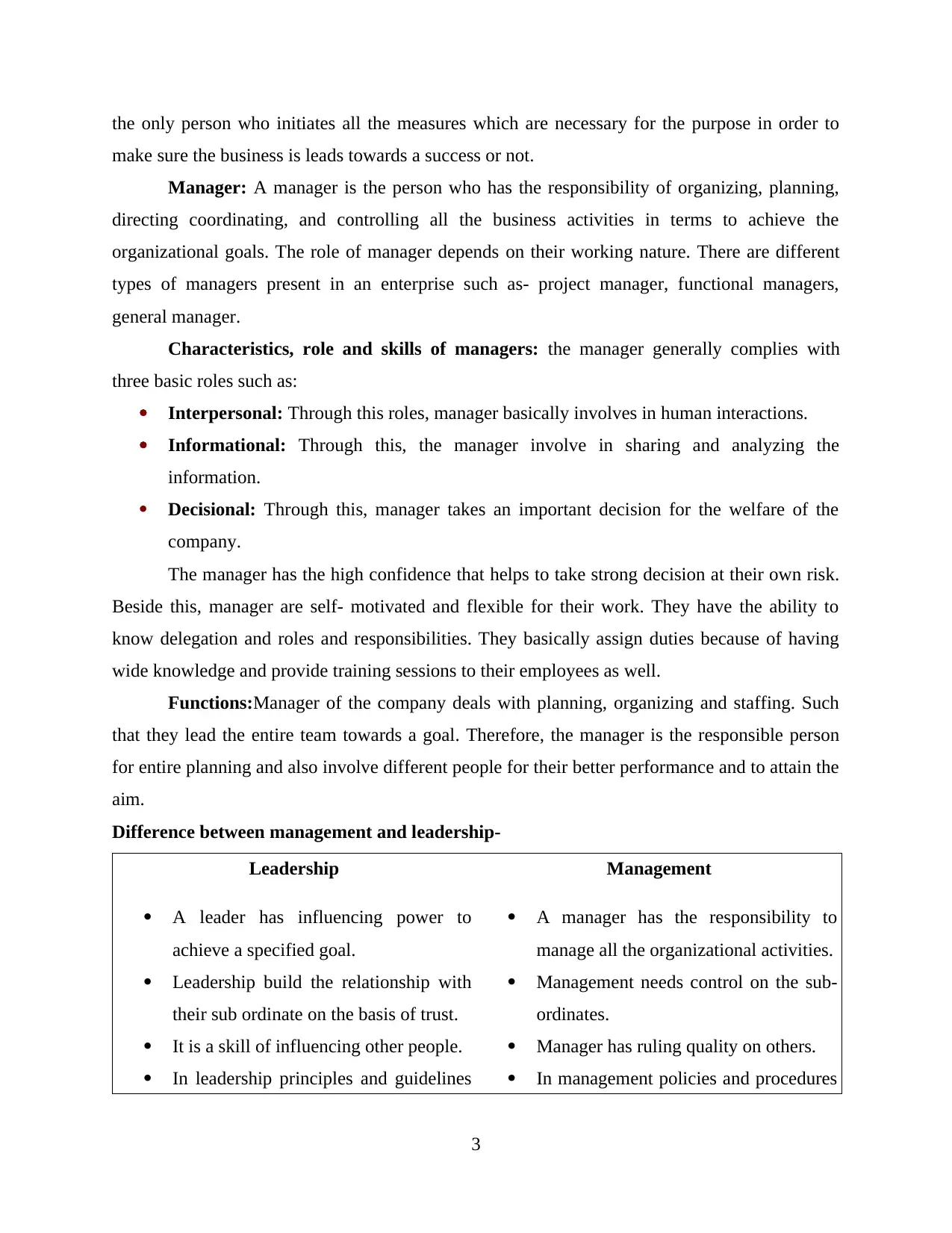
the only person who initiates all the measures which are necessary for the purpose in order to
make sure the business is leads towards a success or not.
Manager: A manager is the person who has the responsibility of organizing, planning,
directing coordinating, and controlling all the business activities in terms to achieve the
organizational goals. The role of manager depends on their working nature. There are different
types of managers present in an enterprise such as- project manager, functional managers,
general manager.
Characteristics, role and skills of managers: the manager generally complies with
three basic roles such as:
Interpersonal: Through this roles, manager basically involves in human interactions.
Informational: Through this, the manager involve in sharing and analyzing the
information.
Decisional: Through this, manager takes an important decision for the welfare of the
company.
The manager has the high confidence that helps to take strong decision at their own risk.
Beside this, manager are self- motivated and flexible for their work. They have the ability to
know delegation and roles and responsibilities. They basically assign duties because of having
wide knowledge and provide training sessions to their employees as well.
Functions:Manager of the company deals with planning, organizing and staffing. Such
that they lead the entire team towards a goal. Therefore, the manager is the responsible person
for entire planning and also involve different people for their better performance and to attain the
aim.
Difference between management and leadership-
Leadership Management
A leader has influencing power to
achieve a specified goal.
Leadership build the relationship with
their sub ordinate on the basis of trust.
It is a skill of influencing other people.
In leadership principles and guidelines
A manager has the responsibility to
manage all the organizational activities.
Management needs control on the sub-
ordinates.
Manager has ruling quality on others.
In management policies and procedures
3
make sure the business is leads towards a success or not.
Manager: A manager is the person who has the responsibility of organizing, planning,
directing coordinating, and controlling all the business activities in terms to achieve the
organizational goals. The role of manager depends on their working nature. There are different
types of managers present in an enterprise such as- project manager, functional managers,
general manager.
Characteristics, role and skills of managers: the manager generally complies with
three basic roles such as:
Interpersonal: Through this roles, manager basically involves in human interactions.
Informational: Through this, the manager involve in sharing and analyzing the
information.
Decisional: Through this, manager takes an important decision for the welfare of the
company.
The manager has the high confidence that helps to take strong decision at their own risk.
Beside this, manager are self- motivated and flexible for their work. They have the ability to
know delegation and roles and responsibilities. They basically assign duties because of having
wide knowledge and provide training sessions to their employees as well.
Functions:Manager of the company deals with planning, organizing and staffing. Such
that they lead the entire team towards a goal. Therefore, the manager is the responsible person
for entire planning and also involve different people for their better performance and to attain the
aim.
Difference between management and leadership-
Leadership Management
A leader has influencing power to
achieve a specified goal.
Leadership build the relationship with
their sub ordinate on the basis of trust.
It is a skill of influencing other people.
In leadership principles and guidelines
A manager has the responsibility to
manage all the organizational activities.
Management needs control on the sub-
ordinates.
Manager has ruling quality on others.
In management policies and procedures
3

are established.
Leadership is proactive.
Leadership brings new changes.
are implemented.
Management reactive in nature.
Management brings stability. A
manager has rights to take the decisions
of organization.
Conclusion: From the above, it is realized that leaders and managers are two important
key aspects of a firm, such that they both work together in order to attain the defined goals in
well manner. Leaders have good communication skills which help to keep motivating their
employees while manager have strong knowledge and develop strategies for the welfare of
Toyota.
P2. Different roles of management and leadership in different organisational situation
Classical theory: It is one of the most traditional theory in which the organization is
considered as a machine and then the workers who are working there are considered as a
different component or part of the machine. Further this model is based upon the accounting
model and also helps to detect the errors and correct them accordingly. If the firm applied this
theory, then it has been analyses that the employees are relatively stable in the terms of change in
an organization.
Behavioral Theory: The theory states some reasons of changing the behavior and also
analyses the consequent of each and every individual by comparing the environment. The theory
also states that there are some conditions occur through which the interactions are to be done
according to the environment.
System Theory: According to this theory, the organizational structure is complex and it
is considered as a complex system in which the organization functions are been carried out
accordingly.
Situational theory- According to this theory a leader chooses the bests course of action
according to the situational variables. According to this theory a lead can make the decision by
analyzing the situation for the various types of decisions. For an example- a leader of the Toyota
company is one of the most knowledgeable and experienced members in their company. In any
complex situation’s leaders can advise to manager to take specific decisions. Situational theory
includes two kinds of leadership style such as- authoritarian style and democratic style. In any
4
Leadership is proactive.
Leadership brings new changes.
are implemented.
Management reactive in nature.
Management brings stability. A
manager has rights to take the decisions
of organization.
Conclusion: From the above, it is realized that leaders and managers are two important
key aspects of a firm, such that they both work together in order to attain the defined goals in
well manner. Leaders have good communication skills which help to keep motivating their
employees while manager have strong knowledge and develop strategies for the welfare of
Toyota.
P2. Different roles of management and leadership in different organisational situation
Classical theory: It is one of the most traditional theory in which the organization is
considered as a machine and then the workers who are working there are considered as a
different component or part of the machine. Further this model is based upon the accounting
model and also helps to detect the errors and correct them accordingly. If the firm applied this
theory, then it has been analyses that the employees are relatively stable in the terms of change in
an organization.
Behavioral Theory: The theory states some reasons of changing the behavior and also
analyses the consequent of each and every individual by comparing the environment. The theory
also states that there are some conditions occur through which the interactions are to be done
according to the environment.
System Theory: According to this theory, the organizational structure is complex and it
is considered as a complex system in which the organization functions are been carried out
accordingly.
Situational theory- According to this theory a leader chooses the bests course of action
according to the situational variables. According to this theory a lead can make the decision by
analyzing the situation for the various types of decisions. For an example- a leader of the Toyota
company is one of the most knowledgeable and experienced members in their company. In any
complex situation’s leaders can advise to manager to take specific decisions. Situational theory
includes two kinds of leadership style such as- authoritarian style and democratic style. In any
4
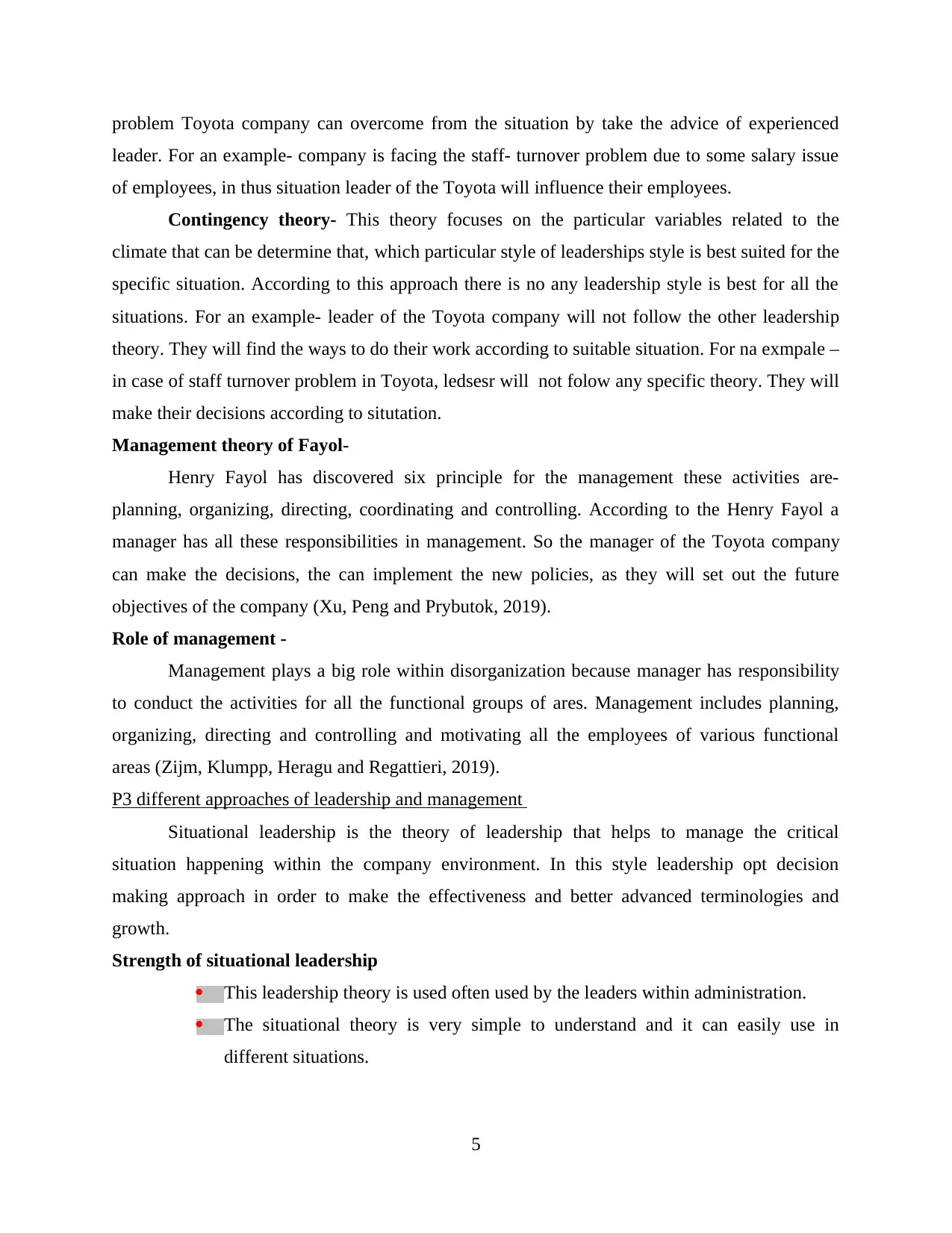
problem Toyota company can overcome from the situation by take the advice of experienced
leader. For an example- company is facing the staff- turnover problem due to some salary issue
of employees, in thus situation leader of the Toyota will influence their employees.
Contingency theory- This theory focuses on the particular variables related to the
climate that can be determine that, which particular style of leaderships style is best suited for the
specific situation. According to this approach there is no any leadership style is best for all the
situations. For an example- leader of the Toyota company will not follow the other leadership
theory. They will find the ways to do their work according to suitable situation. For na exmpale –
in case of staff turnover problem in Toyota, ledsesr will not folow any specific theory. They will
make their decisions according to situtation.
Management theory of Fayol-
Henry Fayol has discovered six principle for the management these activities are-
planning, organizing, directing, coordinating and controlling. According to the Henry Fayol a
manager has all these responsibilities in management. So the manager of the Toyota company
can make the decisions, the can implement the new policies, as they will set out the future
objectives of the company (Xu, Peng and Prybutok, 2019).
Role of management -
Management plays a big role within disorganization because manager has responsibility
to conduct the activities for all the functional groups of ares. Management includes planning,
organizing, directing and controlling and motivating all the employees of various functional
areas (Zijm, Klumpp, Heragu and Regattieri, 2019).
P3 different approaches of leadership and management
Situational leadership is the theory of leadership that helps to manage the critical
situation happening within the company environment. In this style leadership opt decision
making approach in order to make the effectiveness and better advanced terminologies and
growth.
Strength of situational leadership
This leadership theory is used often used by the leaders within administration.
The situational theory is very simple to understand and it can easily use in
different situations.
5
leader. For an example- company is facing the staff- turnover problem due to some salary issue
of employees, in thus situation leader of the Toyota will influence their employees.
Contingency theory- This theory focuses on the particular variables related to the
climate that can be determine that, which particular style of leaderships style is best suited for the
specific situation. According to this approach there is no any leadership style is best for all the
situations. For an example- leader of the Toyota company will not follow the other leadership
theory. They will find the ways to do their work according to suitable situation. For na exmpale –
in case of staff turnover problem in Toyota, ledsesr will not folow any specific theory. They will
make their decisions according to situtation.
Management theory of Fayol-
Henry Fayol has discovered six principle for the management these activities are-
planning, organizing, directing, coordinating and controlling. According to the Henry Fayol a
manager has all these responsibilities in management. So the manager of the Toyota company
can make the decisions, the can implement the new policies, as they will set out the future
objectives of the company (Xu, Peng and Prybutok, 2019).
Role of management -
Management plays a big role within disorganization because manager has responsibility
to conduct the activities for all the functional groups of ares. Management includes planning,
organizing, directing and controlling and motivating all the employees of various functional
areas (Zijm, Klumpp, Heragu and Regattieri, 2019).
P3 different approaches of leadership and management
Situational leadership is the theory of leadership that helps to manage the critical
situation happening within the company environment. In this style leadership opt decision
making approach in order to make the effectiveness and better advanced terminologies and
growth.
Strength of situational leadership
This leadership theory is used often used by the leaders within administration.
The situational theory is very simple to understand and it can easily use in
different situations.
5
Paraphrase This Document
Need a fresh take? Get an instant paraphrase of this document with our AI Paraphraser
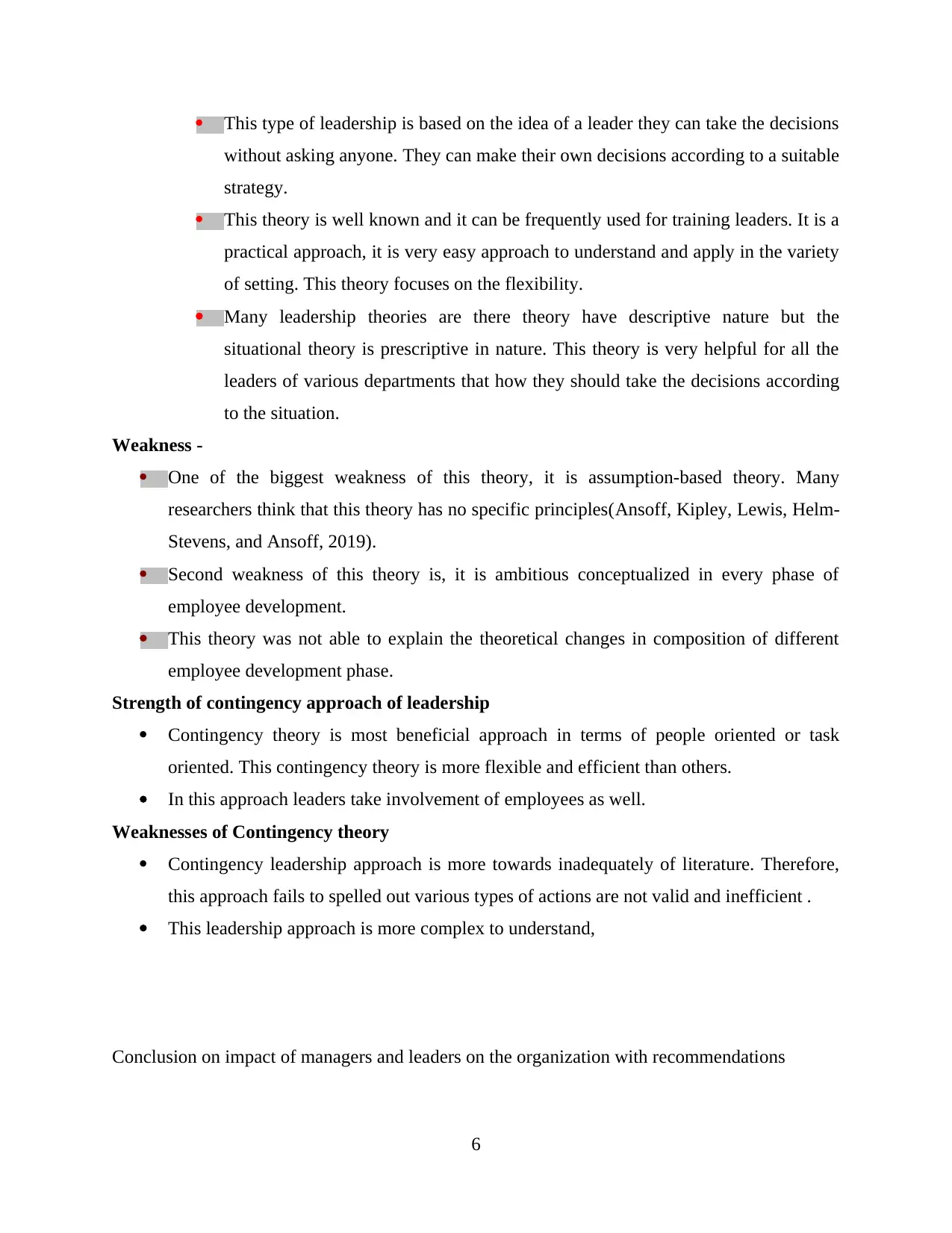
This type of leadership is based on the idea of a leader they can take the decisions
without asking anyone. They can make their own decisions according to a suitable
strategy.
This theory is well known and it can be frequently used for training leaders. It is a
practical approach, it is very easy approach to understand and apply in the variety
of setting. This theory focuses on the flexibility.
Many leadership theories are there theory have descriptive nature but the
situational theory is prescriptive in nature. This theory is very helpful for all the
leaders of various departments that how they should take the decisions according
to the situation.
Weakness -
One of the biggest weakness of this theory, it is assumption-based theory. Many
researchers think that this theory has no specific principles(Ansoff, Kipley, Lewis, Helm-
Stevens, and Ansoff, 2019).
Second weakness of this theory is, it is ambitious conceptualized in every phase of
employee development.
This theory was not able to explain the theoretical changes in composition of different
employee development phase.
Strength of contingency approach of leadership
Contingency theory is most beneficial approach in terms of people oriented or task
oriented. This contingency theory is more flexible and efficient than others.
In this approach leaders take involvement of employees as well.
Weaknesses of Contingency theory
Contingency leadership approach is more towards inadequately of literature. Therefore,
this approach fails to spelled out various types of actions are not valid and inefficient .
This leadership approach is more complex to understand,
Conclusion on impact of managers and leaders on the organization with recommendations
6
without asking anyone. They can make their own decisions according to a suitable
strategy.
This theory is well known and it can be frequently used for training leaders. It is a
practical approach, it is very easy approach to understand and apply in the variety
of setting. This theory focuses on the flexibility.
Many leadership theories are there theory have descriptive nature but the
situational theory is prescriptive in nature. This theory is very helpful for all the
leaders of various departments that how they should take the decisions according
to the situation.
Weakness -
One of the biggest weakness of this theory, it is assumption-based theory. Many
researchers think that this theory has no specific principles(Ansoff, Kipley, Lewis, Helm-
Stevens, and Ansoff, 2019).
Second weakness of this theory is, it is ambitious conceptualized in every phase of
employee development.
This theory was not able to explain the theoretical changes in composition of different
employee development phase.
Strength of contingency approach of leadership
Contingency theory is most beneficial approach in terms of people oriented or task
oriented. This contingency theory is more flexible and efficient than others.
In this approach leaders take involvement of employees as well.
Weaknesses of Contingency theory
Contingency leadership approach is more towards inadequately of literature. Therefore,
this approach fails to spelled out various types of actions are not valid and inefficient .
This leadership approach is more complex to understand,
Conclusion on impact of managers and leaders on the organization with recommendations
6
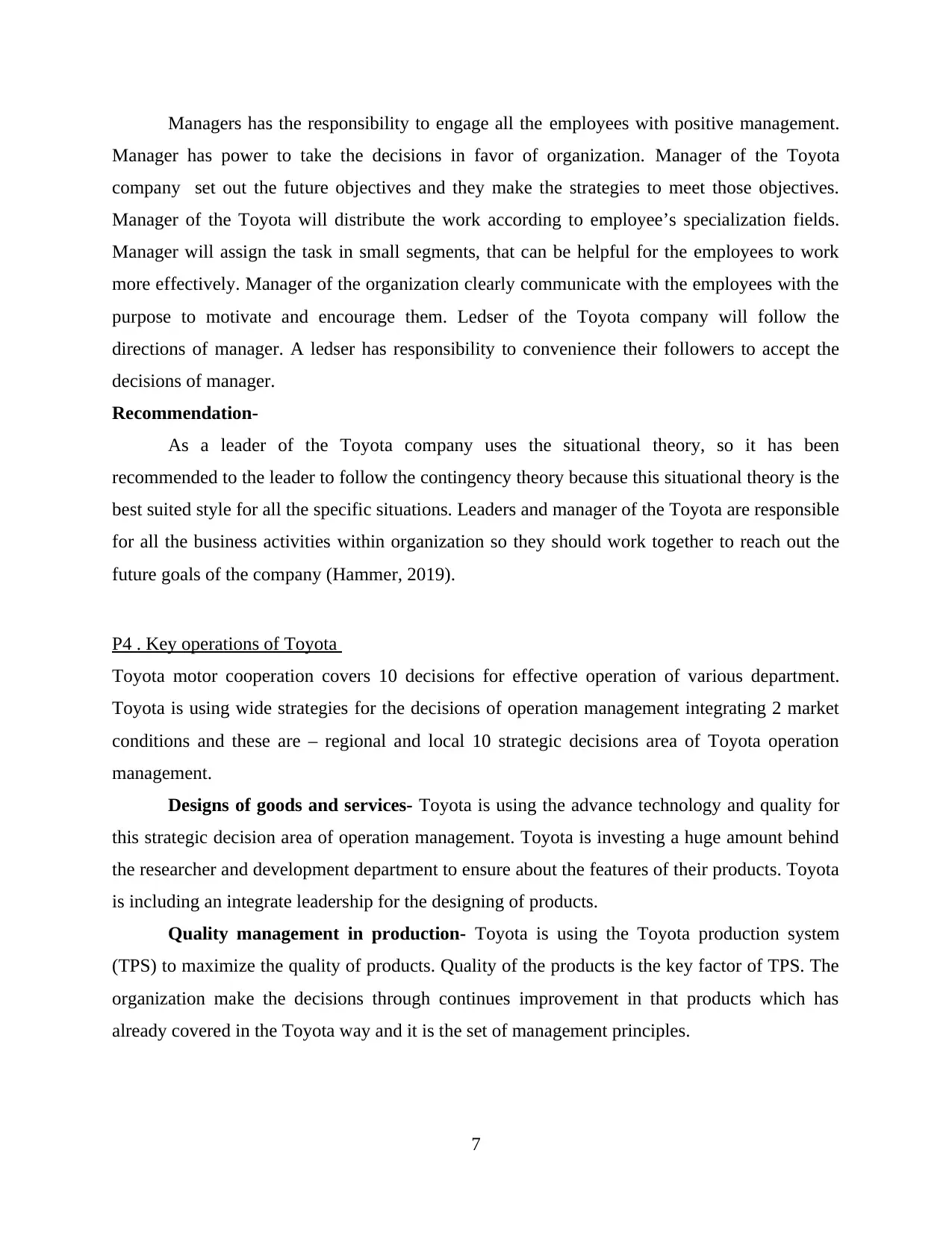
Managers has the responsibility to engage all the employees with positive management.
Manager has power to take the decisions in favor of organization. Manager of the Toyota
company set out the future objectives and they make the strategies to meet those objectives.
Manager of the Toyota will distribute the work according to employee’s specialization fields.
Manager will assign the task in small segments, that can be helpful for the employees to work
more effectively. Manager of the organization clearly communicate with the employees with the
purpose to motivate and encourage them. Ledser of the Toyota company will follow the
directions of manager. A ledser has responsibility to convenience their followers to accept the
decisions of manager.
Recommendation-
As a leader of the Toyota company uses the situational theory, so it has been
recommended to the leader to follow the contingency theory because this situational theory is the
best suited style for all the specific situations. Leaders and manager of the Toyota are responsible
for all the business activities within organization so they should work together to reach out the
future goals of the company (Hammer, 2019).
P4 . Key operations of Toyota
Toyota motor cooperation covers 10 decisions for effective operation of various department.
Toyota is using wide strategies for the decisions of operation management integrating 2 market
conditions and these are – regional and local 10 strategic decisions area of Toyota operation
management.
Designs of goods and services- Toyota is using the advance technology and quality for
this strategic decision area of operation management. Toyota is investing a huge amount behind
the researcher and development department to ensure about the features of their products. Toyota
is including an integrate leadership for the designing of products.
Quality management in production- Toyota is using the Toyota production system
(TPS) to maximize the quality of products. Quality of the products is the key factor of TPS. The
organization make the decisions through continues improvement in that products which has
already covered in the Toyota way and it is the set of management principles.
7
Manager has power to take the decisions in favor of organization. Manager of the Toyota
company set out the future objectives and they make the strategies to meet those objectives.
Manager of the Toyota will distribute the work according to employee’s specialization fields.
Manager will assign the task in small segments, that can be helpful for the employees to work
more effectively. Manager of the organization clearly communicate with the employees with the
purpose to motivate and encourage them. Ledser of the Toyota company will follow the
directions of manager. A ledser has responsibility to convenience their followers to accept the
decisions of manager.
Recommendation-
As a leader of the Toyota company uses the situational theory, so it has been
recommended to the leader to follow the contingency theory because this situational theory is the
best suited style for all the specific situations. Leaders and manager of the Toyota are responsible
for all the business activities within organization so they should work together to reach out the
future goals of the company (Hammer, 2019).
P4 . Key operations of Toyota
Toyota motor cooperation covers 10 decisions for effective operation of various department.
Toyota is using wide strategies for the decisions of operation management integrating 2 market
conditions and these are – regional and local 10 strategic decisions area of Toyota operation
management.
Designs of goods and services- Toyota is using the advance technology and quality for
this strategic decision area of operation management. Toyota is investing a huge amount behind
the researcher and development department to ensure about the features of their products. Toyota
is including an integrate leadership for the designing of products.
Quality management in production- Toyota is using the Toyota production system
(TPS) to maximize the quality of products. Quality of the products is the key factor of TPS. The
organization make the decisions through continues improvement in that products which has
already covered in the Toyota way and it is the set of management principles.
7
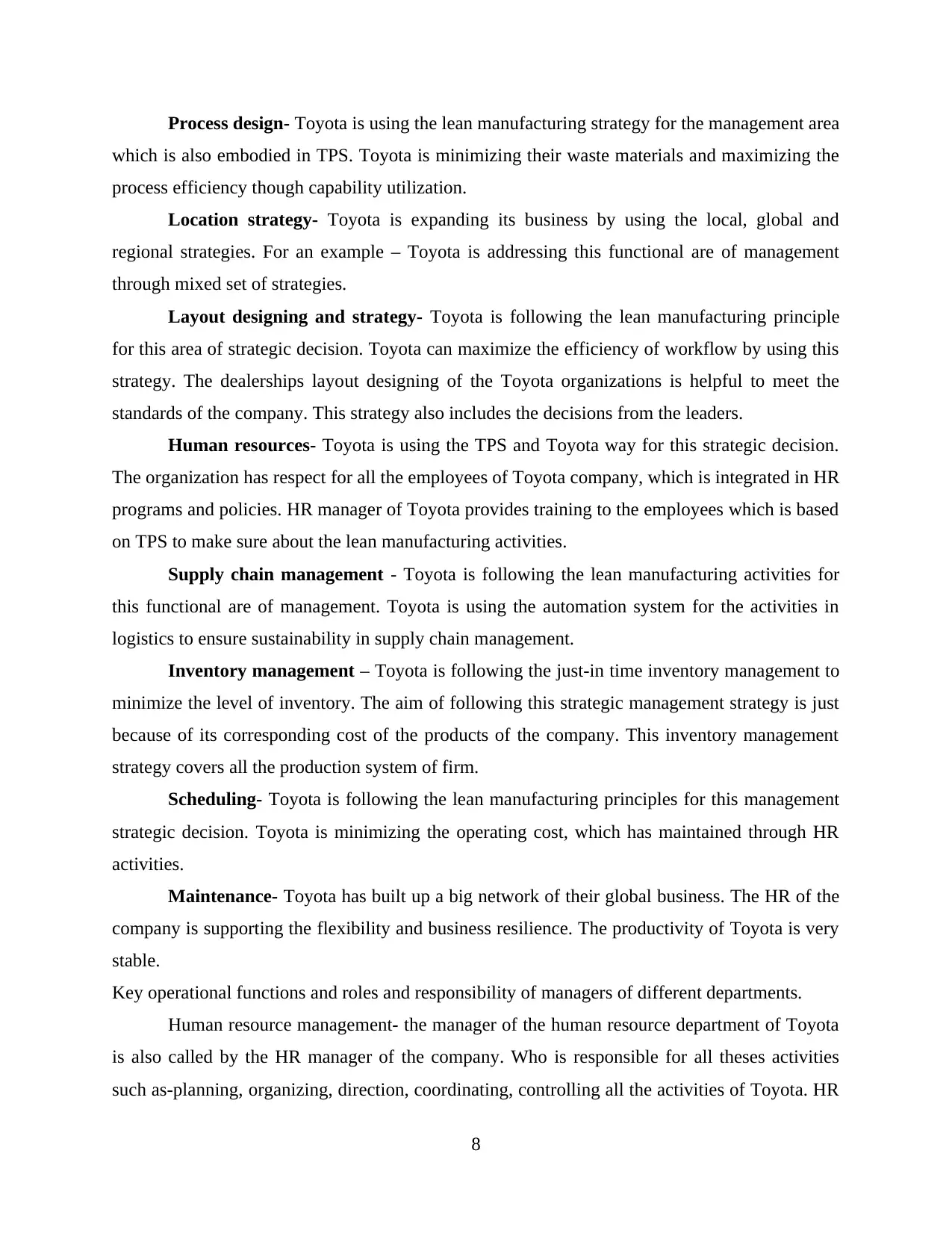
Process design- Toyota is using the lean manufacturing strategy for the management area
which is also embodied in TPS. Toyota is minimizing their waste materials and maximizing the
process efficiency though capability utilization.
Location strategy- Toyota is expanding its business by using the local, global and
regional strategies. For an example – Toyota is addressing this functional are of management
through mixed set of strategies.
Layout designing and strategy- Toyota is following the lean manufacturing principle
for this area of strategic decision. Toyota can maximize the efficiency of workflow by using this
strategy. The dealerships layout designing of the Toyota organizations is helpful to meet the
standards of the company. This strategy also includes the decisions from the leaders.
Human resources- Toyota is using the TPS and Toyota way for this strategic decision.
The organization has respect for all the employees of Toyota company, which is integrated in HR
programs and policies. HR manager of Toyota provides training to the employees which is based
on TPS to make sure about the lean manufacturing activities.
Supply chain management - Toyota is following the lean manufacturing activities for
this functional are of management. Toyota is using the automation system for the activities in
logistics to ensure sustainability in supply chain management.
Inventory management – Toyota is following the just-in time inventory management to
minimize the level of inventory. The aim of following this strategic management strategy is just
because of its corresponding cost of the products of the company. This inventory management
strategy covers all the production system of firm.
Scheduling- Toyota is following the lean manufacturing principles for this management
strategic decision. Toyota is minimizing the operating cost, which has maintained through HR
activities.
Maintenance- Toyota has built up a big network of their global business. The HR of the
company is supporting the flexibility and business resilience. The productivity of Toyota is very
stable.
Key operational functions and roles and responsibility of managers of different departments.
Human resource management- the manager of the human resource department of Toyota
is also called by the HR manager of the company. Who is responsible for all theses activities
such as-planning, organizing, direction, coordinating, controlling all the activities of Toyota. HR
8
which is also embodied in TPS. Toyota is minimizing their waste materials and maximizing the
process efficiency though capability utilization.
Location strategy- Toyota is expanding its business by using the local, global and
regional strategies. For an example – Toyota is addressing this functional are of management
through mixed set of strategies.
Layout designing and strategy- Toyota is following the lean manufacturing principle
for this area of strategic decision. Toyota can maximize the efficiency of workflow by using this
strategy. The dealerships layout designing of the Toyota organizations is helpful to meet the
standards of the company. This strategy also includes the decisions from the leaders.
Human resources- Toyota is using the TPS and Toyota way for this strategic decision.
The organization has respect for all the employees of Toyota company, which is integrated in HR
programs and policies. HR manager of Toyota provides training to the employees which is based
on TPS to make sure about the lean manufacturing activities.
Supply chain management - Toyota is following the lean manufacturing activities for
this functional are of management. Toyota is using the automation system for the activities in
logistics to ensure sustainability in supply chain management.
Inventory management – Toyota is following the just-in time inventory management to
minimize the level of inventory. The aim of following this strategic management strategy is just
because of its corresponding cost of the products of the company. This inventory management
strategy covers all the production system of firm.
Scheduling- Toyota is following the lean manufacturing principles for this management
strategic decision. Toyota is minimizing the operating cost, which has maintained through HR
activities.
Maintenance- Toyota has built up a big network of their global business. The HR of the
company is supporting the flexibility and business resilience. The productivity of Toyota is very
stable.
Key operational functions and roles and responsibility of managers of different departments.
Human resource management- the manager of the human resource department of Toyota
is also called by the HR manager of the company. Who is responsible for all theses activities
such as-planning, organizing, direction, coordinating, controlling all the activities of Toyota. HR
8
Secure Best Marks with AI Grader
Need help grading? Try our AI Grader for instant feedback on your assignments.
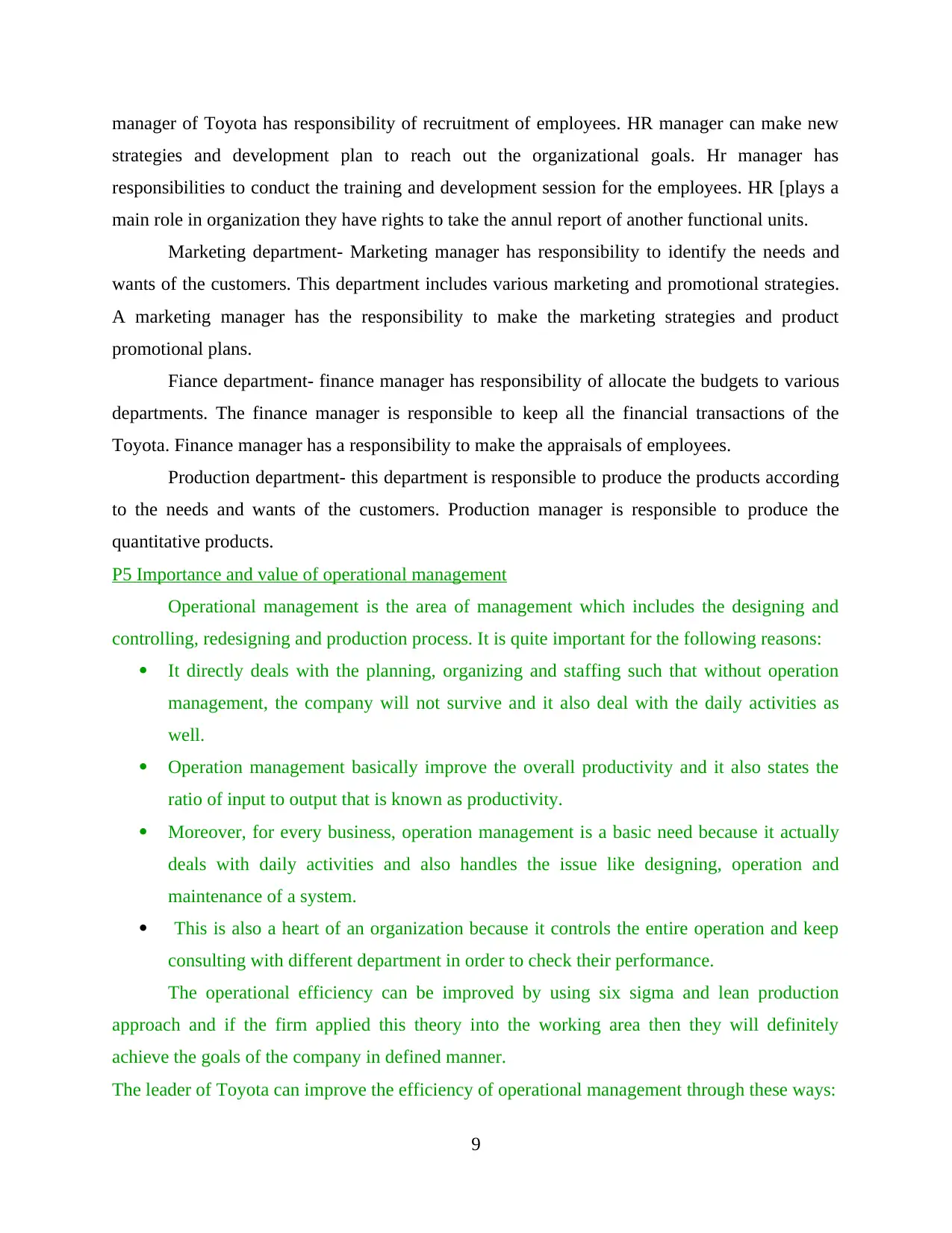
manager of Toyota has responsibility of recruitment of employees. HR manager can make new
strategies and development plan to reach out the organizational goals. Hr manager has
responsibilities to conduct the training and development session for the employees. HR [plays a
main role in organization they have rights to take the annul report of another functional units.
Marketing department- Marketing manager has responsibility to identify the needs and
wants of the customers. This department includes various marketing and promotional strategies.
A marketing manager has the responsibility to make the marketing strategies and product
promotional plans.
Fiance department- finance manager has responsibility of allocate the budgets to various
departments. The finance manager is responsible to keep all the financial transactions of the
Toyota. Finance manager has a responsibility to make the appraisals of employees.
Production department- this department is responsible to produce the products according
to the needs and wants of the customers. Production manager is responsible to produce the
quantitative products.
P5 Importance and value of operational management
Operational management is the area of management which includes the designing and
controlling, redesigning and production process. It is quite important for the following reasons:
It directly deals with the planning, organizing and staffing such that without operation
management, the company will not survive and it also deal with the daily activities as
well.
Operation management basically improve the overall productivity and it also states the
ratio of input to output that is known as productivity.
Moreover, for every business, operation management is a basic need because it actually
deals with daily activities and also handles the issue like designing, operation and
maintenance of a system.
This is also a heart of an organization because it controls the entire operation and keep
consulting with different department in order to check their performance.
The operational efficiency can be improved by using six sigma and lean production
approach and if the firm applied this theory into the working area then they will definitely
achieve the goals of the company in defined manner.
The leader of Toyota can improve the efficiency of operational management through these ways:
9
strategies and development plan to reach out the organizational goals. Hr manager has
responsibilities to conduct the training and development session for the employees. HR [plays a
main role in organization they have rights to take the annul report of another functional units.
Marketing department- Marketing manager has responsibility to identify the needs and
wants of the customers. This department includes various marketing and promotional strategies.
A marketing manager has the responsibility to make the marketing strategies and product
promotional plans.
Fiance department- finance manager has responsibility of allocate the budgets to various
departments. The finance manager is responsible to keep all the financial transactions of the
Toyota. Finance manager has a responsibility to make the appraisals of employees.
Production department- this department is responsible to produce the products according
to the needs and wants of the customers. Production manager is responsible to produce the
quantitative products.
P5 Importance and value of operational management
Operational management is the area of management which includes the designing and
controlling, redesigning and production process. It is quite important for the following reasons:
It directly deals with the planning, organizing and staffing such that without operation
management, the company will not survive and it also deal with the daily activities as
well.
Operation management basically improve the overall productivity and it also states the
ratio of input to output that is known as productivity.
Moreover, for every business, operation management is a basic need because it actually
deals with daily activities and also handles the issue like designing, operation and
maintenance of a system.
This is also a heart of an organization because it controls the entire operation and keep
consulting with different department in order to check their performance.
The operational efficiency can be improved by using six sigma and lean production
approach and if the firm applied this theory into the working area then they will definitely
achieve the goals of the company in defined manner.
The leader of Toyota can improve the efficiency of operational management through these ways:
9
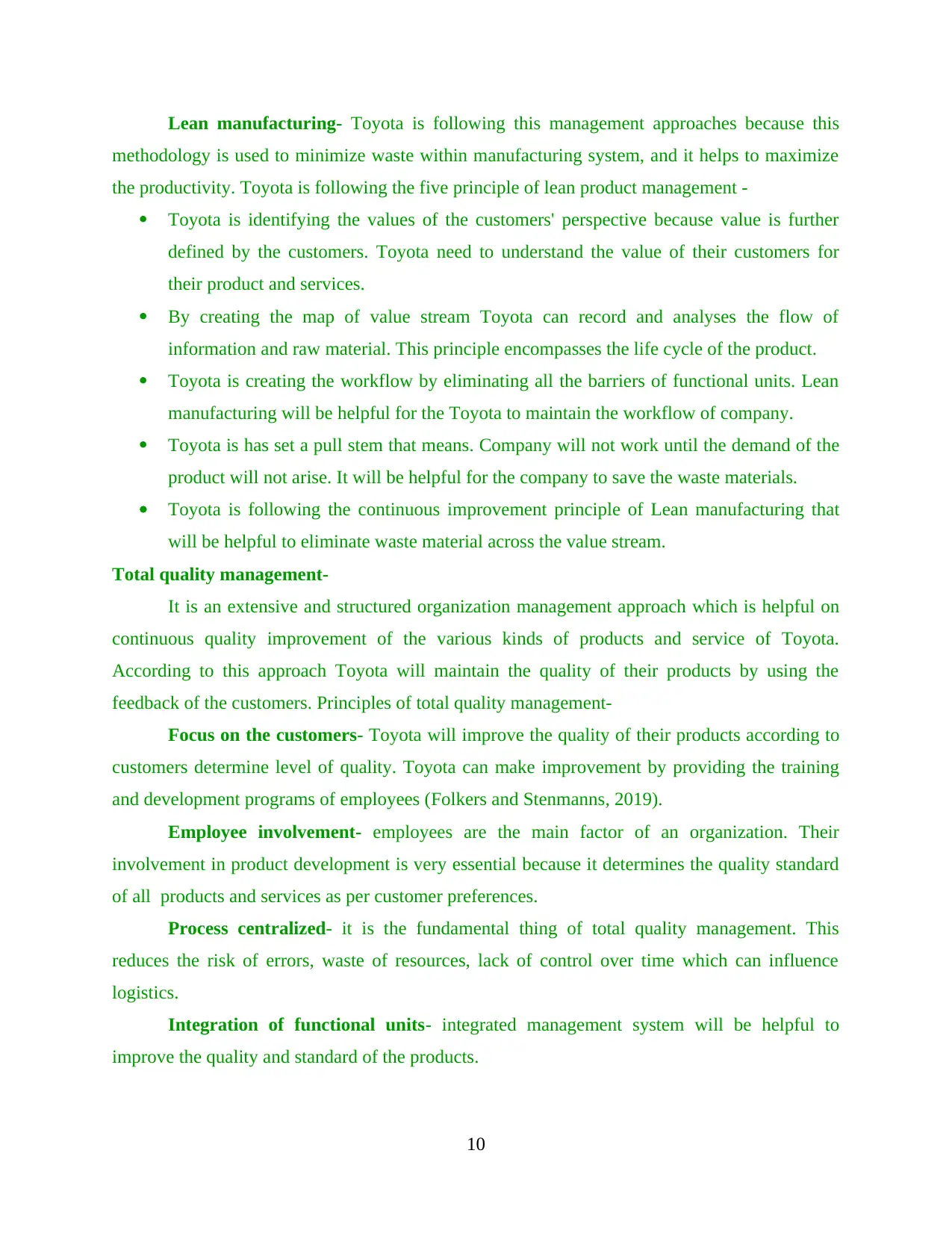
Lean manufacturing- Toyota is following this management approaches because this
methodology is used to minimize waste within manufacturing system, and it helps to maximize
the productivity. Toyota is following the five principle of lean product management -
Toyota is identifying the values of the customers' perspective because value is further
defined by the customers. Toyota need to understand the value of their customers for
their product and services.
By creating the map of value stream Toyota can record and analyses the flow of
information and raw material. This principle encompasses the life cycle of the product.
Toyota is creating the workflow by eliminating all the barriers of functional units. Lean
manufacturing will be helpful for the Toyota to maintain the workflow of company.
Toyota is has set a pull stem that means. Company will not work until the demand of the
product will not arise. It will be helpful for the company to save the waste materials.
Toyota is following the continuous improvement principle of Lean manufacturing that
will be helpful to eliminate waste material across the value stream.
Total quality management-
It is an extensive and structured organization management approach which is helpful on
continuous quality improvement of the various kinds of products and service of Toyota.
According to this approach Toyota will maintain the quality of their products by using the
feedback of the customers. Principles of total quality management-
Focus on the customers- Toyota will improve the quality of their products according to
customers determine level of quality. Toyota can make improvement by providing the training
and development programs of employees (Folkers and Stenmanns, 2019).
Employee involvement- employees are the main factor of an organization. Their
involvement in product development is very essential because it determines the quality standard
of all products and services as per customer preferences.
Process centralized- it is the fundamental thing of total quality management. This
reduces the risk of errors, waste of resources, lack of control over time which can influence
logistics.
Integration of functional units- integrated management system will be helpful to
improve the quality and standard of the products.
10
methodology is used to minimize waste within manufacturing system, and it helps to maximize
the productivity. Toyota is following the five principle of lean product management -
Toyota is identifying the values of the customers' perspective because value is further
defined by the customers. Toyota need to understand the value of their customers for
their product and services.
By creating the map of value stream Toyota can record and analyses the flow of
information and raw material. This principle encompasses the life cycle of the product.
Toyota is creating the workflow by eliminating all the barriers of functional units. Lean
manufacturing will be helpful for the Toyota to maintain the workflow of company.
Toyota is has set a pull stem that means. Company will not work until the demand of the
product will not arise. It will be helpful for the company to save the waste materials.
Toyota is following the continuous improvement principle of Lean manufacturing that
will be helpful to eliminate waste material across the value stream.
Total quality management-
It is an extensive and structured organization management approach which is helpful on
continuous quality improvement of the various kinds of products and service of Toyota.
According to this approach Toyota will maintain the quality of their products by using the
feedback of the customers. Principles of total quality management-
Focus on the customers- Toyota will improve the quality of their products according to
customers determine level of quality. Toyota can make improvement by providing the training
and development programs of employees (Folkers and Stenmanns, 2019).
Employee involvement- employees are the main factor of an organization. Their
involvement in product development is very essential because it determines the quality standard
of all products and services as per customer preferences.
Process centralized- it is the fundamental thing of total quality management. This
reduces the risk of errors, waste of resources, lack of control over time which can influence
logistics.
Integration of functional units- integrated management system will be helpful to
improve the quality and standard of the products.
10
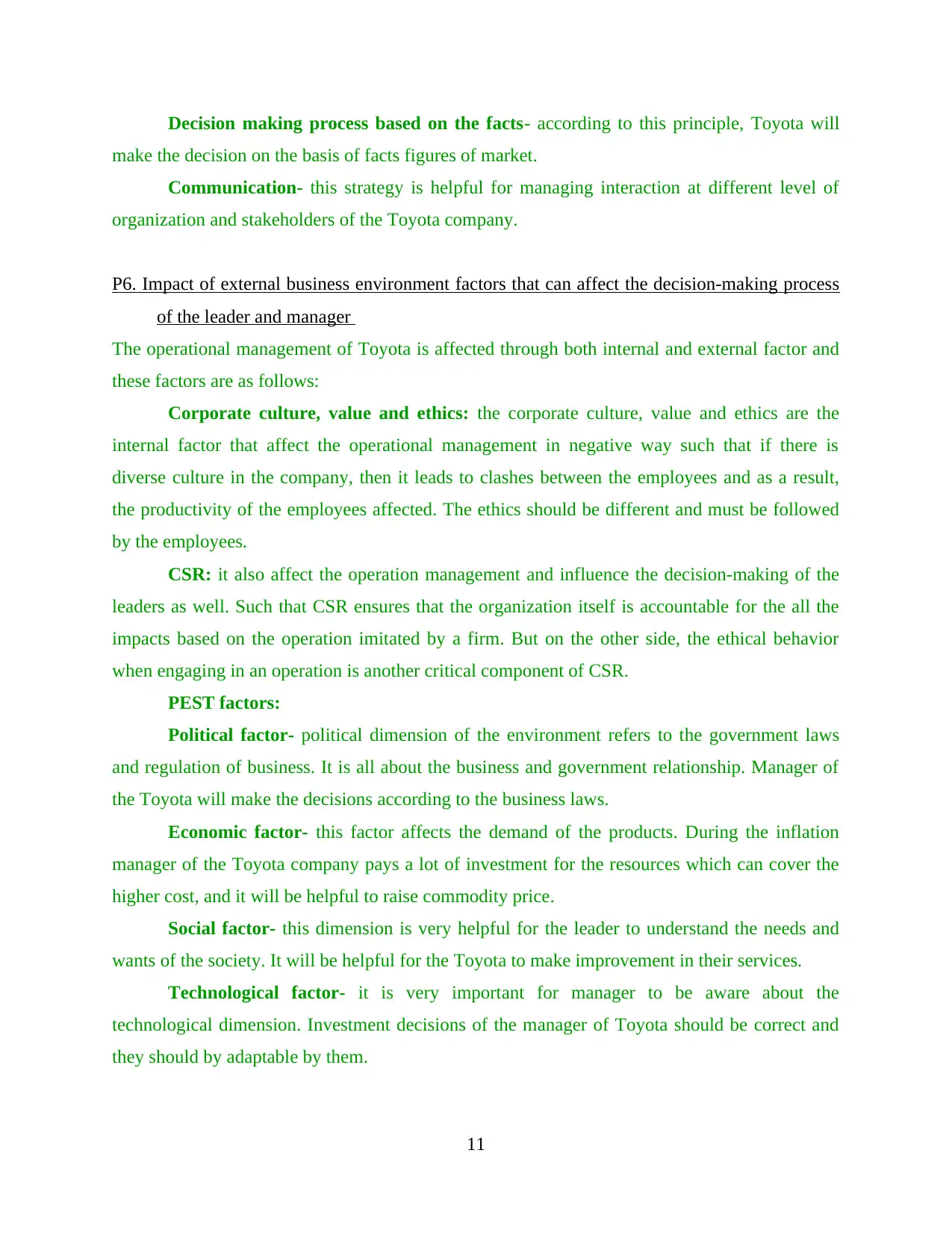
Decision making process based on the facts- according to this principle, Toyota will
make the decision on the basis of facts figures of market.
Communication- this strategy is helpful for managing interaction at different level of
organization and stakeholders of the Toyota company.
P6. Impact of external business environment factors that can affect the decision-making process
of the leader and manager
The operational management of Toyota is affected through both internal and external factor and
these factors are as follows:
Corporate culture, value and ethics: the corporate culture, value and ethics are the
internal factor that affect the operational management in negative way such that if there is
diverse culture in the company, then it leads to clashes between the employees and as a result,
the productivity of the employees affected. The ethics should be different and must be followed
by the employees.
CSR: it also affect the operation management and influence the decision-making of the
leaders as well. Such that CSR ensures that the organization itself is accountable for the all the
impacts based on the operation imitated by a firm. But on the other side, the ethical behavior
when engaging in an operation is another critical component of CSR.
PEST factors:
Political factor- political dimension of the environment refers to the government laws
and regulation of business. It is all about the business and government relationship. Manager of
the Toyota will make the decisions according to the business laws.
Economic factor- this factor affects the demand of the products. During the inflation
manager of the Toyota company pays a lot of investment for the resources which can cover the
higher cost, and it will be helpful to raise commodity price.
Social factor- this dimension is very helpful for the leader to understand the needs and
wants of the society. It will be helpful for the Toyota to make improvement in their services.
Technological factor- it is very important for manager to be aware about the
technological dimension. Investment decisions of the manager of Toyota should be correct and
they should by adaptable by them.
11
make the decision on the basis of facts figures of market.
Communication- this strategy is helpful for managing interaction at different level of
organization and stakeholders of the Toyota company.
P6. Impact of external business environment factors that can affect the decision-making process
of the leader and manager
The operational management of Toyota is affected through both internal and external factor and
these factors are as follows:
Corporate culture, value and ethics: the corporate culture, value and ethics are the
internal factor that affect the operational management in negative way such that if there is
diverse culture in the company, then it leads to clashes between the employees and as a result,
the productivity of the employees affected. The ethics should be different and must be followed
by the employees.
CSR: it also affect the operation management and influence the decision-making of the
leaders as well. Such that CSR ensures that the organization itself is accountable for the all the
impacts based on the operation imitated by a firm. But on the other side, the ethical behavior
when engaging in an operation is another critical component of CSR.
PEST factors:
Political factor- political dimension of the environment refers to the government laws
and regulation of business. It is all about the business and government relationship. Manager of
the Toyota will make the decisions according to the business laws.
Economic factor- this factor affects the demand of the products. During the inflation
manager of the Toyota company pays a lot of investment for the resources which can cover the
higher cost, and it will be helpful to raise commodity price.
Social factor- this dimension is very helpful for the leader to understand the needs and
wants of the society. It will be helpful for the Toyota to make improvement in their services.
Technological factor- it is very important for manager to be aware about the
technological dimension. Investment decisions of the manager of Toyota should be correct and
they should by adaptable by them.
11
Paraphrase This Document
Need a fresh take? Get an instant paraphrase of this document with our AI Paraphraser
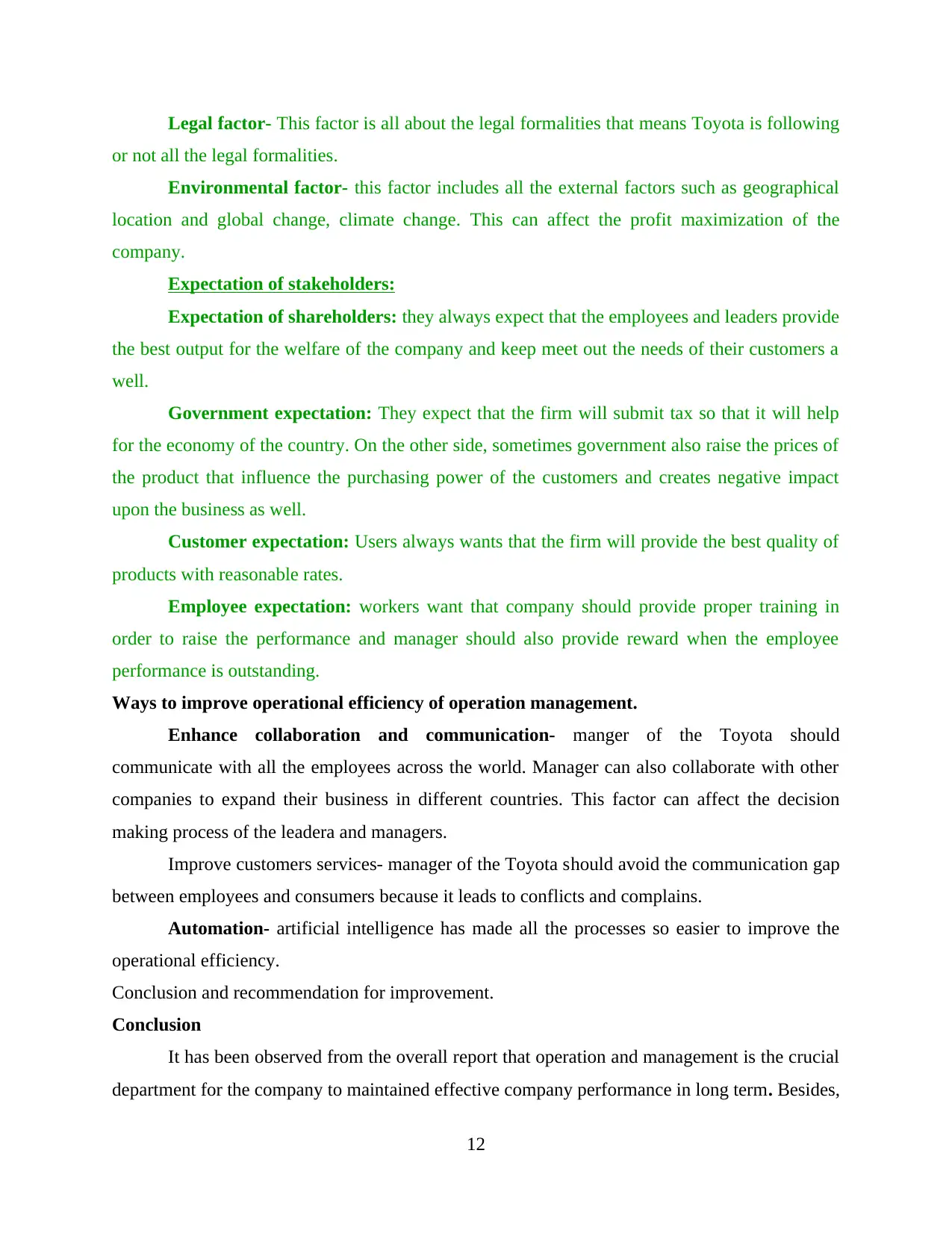
Legal factor- This factor is all about the legal formalities that means Toyota is following
or not all the legal formalities.
Environmental factor- this factor includes all the external factors such as geographical
location and global change, climate change. This can affect the profit maximization of the
company.
Expectation of stakeholders:
Expectation of shareholders: they always expect that the employees and leaders provide
the best output for the welfare of the company and keep meet out the needs of their customers a
well.
Government expectation: They expect that the firm will submit tax so that it will help
for the economy of the country. On the other side, sometimes government also raise the prices of
the product that influence the purchasing power of the customers and creates negative impact
upon the business as well.
Customer expectation: Users always wants that the firm will provide the best quality of
products with reasonable rates.
Employee expectation: workers want that company should provide proper training in
order to raise the performance and manager should also provide reward when the employee
performance is outstanding.
Ways to improve operational efficiency of operation management.
Enhance collaboration and communication- manger of the Toyota should
communicate with all the employees across the world. Manager can also collaborate with other
companies to expand their business in different countries. This factor can affect the decision
making process of the leadera and managers.
Improve customers services- manager of the Toyota should avoid the communication gap
between employees and consumers because it leads to conflicts and complains.
Automation- artificial intelligence has made all the processes so easier to improve the
operational efficiency.
Conclusion and recommendation for improvement.
Conclusion
It has been observed from the overall report that operation and management is the crucial
department for the company to maintained effective company performance in long term. Besides,
12
or not all the legal formalities.
Environmental factor- this factor includes all the external factors such as geographical
location and global change, climate change. This can affect the profit maximization of the
company.
Expectation of stakeholders:
Expectation of shareholders: they always expect that the employees and leaders provide
the best output for the welfare of the company and keep meet out the needs of their customers a
well.
Government expectation: They expect that the firm will submit tax so that it will help
for the economy of the country. On the other side, sometimes government also raise the prices of
the product that influence the purchasing power of the customers and creates negative impact
upon the business as well.
Customer expectation: Users always wants that the firm will provide the best quality of
products with reasonable rates.
Employee expectation: workers want that company should provide proper training in
order to raise the performance and manager should also provide reward when the employee
performance is outstanding.
Ways to improve operational efficiency of operation management.
Enhance collaboration and communication- manger of the Toyota should
communicate with all the employees across the world. Manager can also collaborate with other
companies to expand their business in different countries. This factor can affect the decision
making process of the leadera and managers.
Improve customers services- manager of the Toyota should avoid the communication gap
between employees and consumers because it leads to conflicts and complains.
Automation- artificial intelligence has made all the processes so easier to improve the
operational efficiency.
Conclusion and recommendation for improvement.
Conclusion
It has been observed from the overall report that operation and management is the crucial
department for the company to maintained effective company performance in long term. Besides,
12
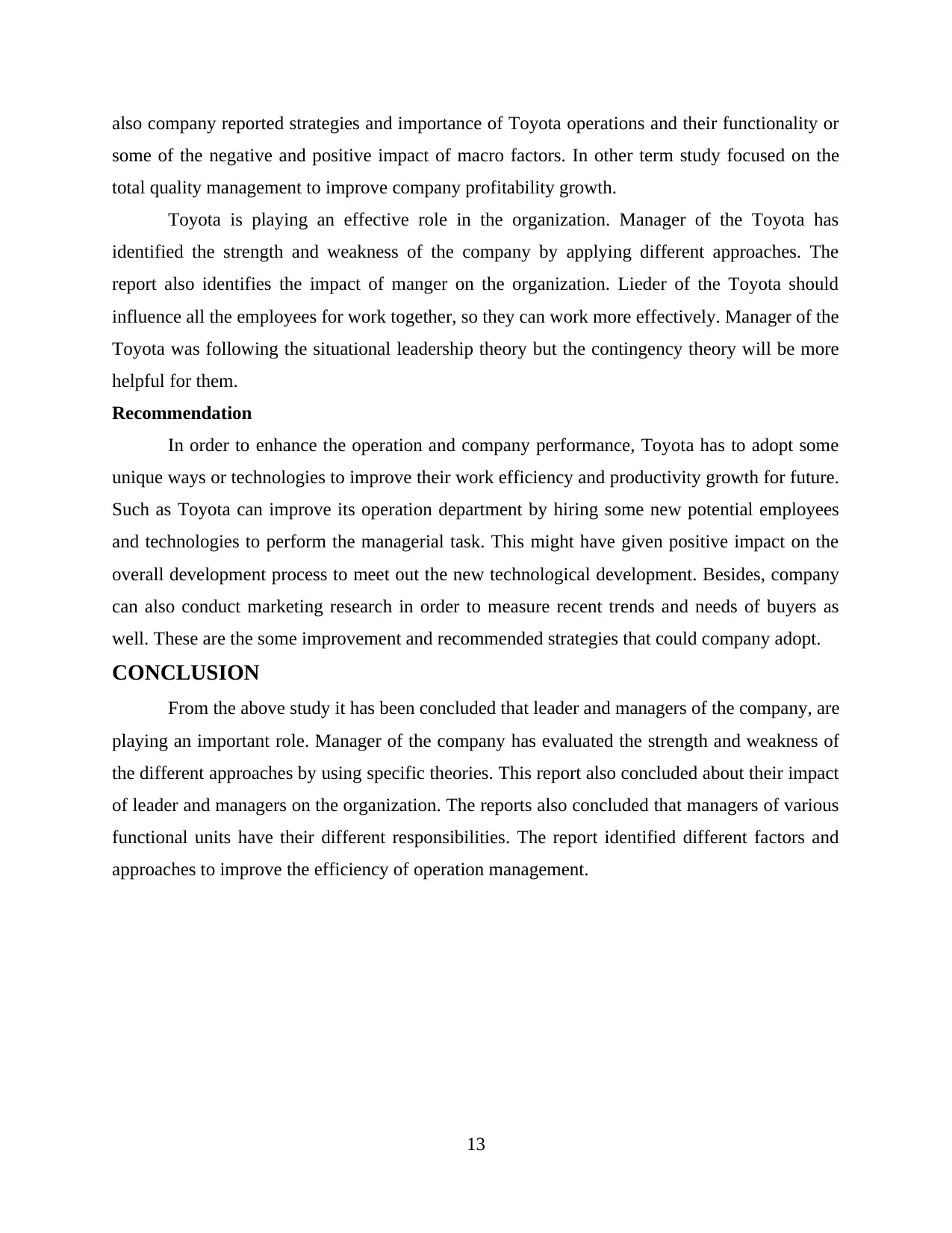
also company reported strategies and importance of Toyota operations and their functionality or
some of the negative and positive impact of macro factors. In other term study focused on the
total quality management to improve company profitability growth.
Toyota is playing an effective role in the organization. Manager of the Toyota has
identified the strength and weakness of the company by applying different approaches. The
report also identifies the impact of manger on the organization. Lieder of the Toyota should
influence all the employees for work together, so they can work more effectively. Manager of the
Toyota was following the situational leadership theory but the contingency theory will be more
helpful for them.
Recommendation
In order to enhance the operation and company performance, Toyota has to adopt some
unique ways or technologies to improve their work efficiency and productivity growth for future.
Such as Toyota can improve its operation department by hiring some new potential employees
and technologies to perform the managerial task. This might have given positive impact on the
overall development process to meet out the new technological development. Besides, company
can also conduct marketing research in order to measure recent trends and needs of buyers as
well. These are the some improvement and recommended strategies that could company adopt.
CONCLUSION
From the above study it has been concluded that leader and managers of the company, are
playing an important role. Manager of the company has evaluated the strength and weakness of
the different approaches by using specific theories. This report also concluded about their impact
of leader and managers on the organization. The reports also concluded that managers of various
functional units have their different responsibilities. The report identified different factors and
approaches to improve the efficiency of operation management.
13
some of the negative and positive impact of macro factors. In other term study focused on the
total quality management to improve company profitability growth.
Toyota is playing an effective role in the organization. Manager of the Toyota has
identified the strength and weakness of the company by applying different approaches. The
report also identifies the impact of manger on the organization. Lieder of the Toyota should
influence all the employees for work together, so they can work more effectively. Manager of the
Toyota was following the situational leadership theory but the contingency theory will be more
helpful for them.
Recommendation
In order to enhance the operation and company performance, Toyota has to adopt some
unique ways or technologies to improve their work efficiency and productivity growth for future.
Such as Toyota can improve its operation department by hiring some new potential employees
and technologies to perform the managerial task. This might have given positive impact on the
overall development process to meet out the new technological development. Besides, company
can also conduct marketing research in order to measure recent trends and needs of buyers as
well. These are the some improvement and recommended strategies that could company adopt.
CONCLUSION
From the above study it has been concluded that leader and managers of the company, are
playing an important role. Manager of the company has evaluated the strength and weakness of
the different approaches by using specific theories. This report also concluded about their impact
of leader and managers on the organization. The reports also concluded that managers of various
functional units have their different responsibilities. The report identified different factors and
approaches to improve the efficiency of operation management.
13

14
Secure Best Marks with AI Grader
Need help grading? Try our AI Grader for instant feedback on your assignments.
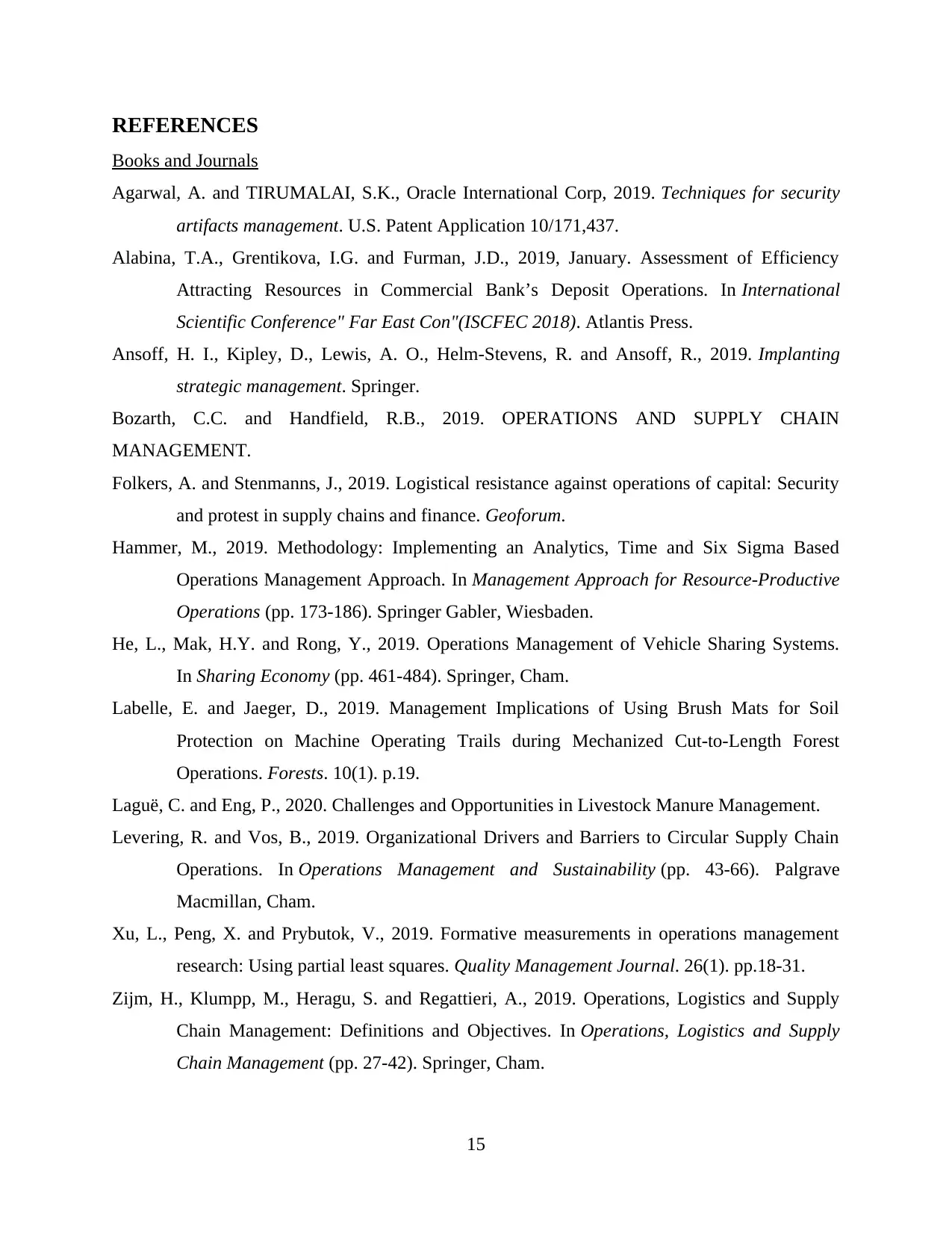
REFERENCES
Books and Journals
Agarwal, A. and TIRUMALAI, S.K., Oracle International Corp, 2019. Techniques for security
artifacts management. U.S. Patent Application 10/171,437.
Alаbinа, T.A., Grentikova, I.G. and Furman, J.D., 2019, January. Assessment of Efficiency
Attracting Resources in Commercial Bank’s Deposit Operations. In International
Scientific Conference" Far East Con"(ISCFEC 2018). Atlantis Press.
Ansoff, H. I., Kipley, D., Lewis, A. O., Helm-Stevens, R. and Ansoff, R., 2019. Implanting
strategic management. Springer.
Bozarth, C.C. and Handfield, R.B., 2019. OPERATIONS AND SUPPLY CHAIN
MANAGEMENT.
Folkers, A. and Stenmanns, J., 2019. Logistical resistance against operations of capital: Security
and protest in supply chains and finance. Geoforum.
Hammer, M., 2019. Methodology: Implementing an Analytics, Time and Six Sigma Based
Operations Management Approach. In Management Approach for Resource-Productive
Operations (pp. 173-186). Springer Gabler, Wiesbaden.
He, L., Mak, H.Y. and Rong, Y., 2019. Operations Management of Vehicle Sharing Systems.
In Sharing Economy (pp. 461-484). Springer, Cham.
Labelle, E. and Jaeger, D., 2019. Management Implications of Using Brush Mats for Soil
Protection on Machine Operating Trails during Mechanized Cut-to-Length Forest
Operations. Forests. 10(1). p.19.
Laguë, C. and Eng, P., 2020. Challenges and Opportunities in Livestock Manure Management.
Levering, R. and Vos, B., 2019. Organizational Drivers and Barriers to Circular Supply Chain
Operations. In Operations Management and Sustainability (pp. 43-66). Palgrave
Macmillan, Cham.
Xu, L., Peng, X. and Prybutok, V., 2019. Formative measurements in operations management
research: Using partial least squares. Quality Management Journal. 26(1). pp.18-31.
Zijm, H., Klumpp, M., Heragu, S. and Regattieri, A., 2019. Operations, Logistics and Supply
Chain Management: Definitions and Objectives. In Operations, Logistics and Supply
Chain Management (pp. 27-42). Springer, Cham.
15
Books and Journals
Agarwal, A. and TIRUMALAI, S.K., Oracle International Corp, 2019. Techniques for security
artifacts management. U.S. Patent Application 10/171,437.
Alаbinа, T.A., Grentikova, I.G. and Furman, J.D., 2019, January. Assessment of Efficiency
Attracting Resources in Commercial Bank’s Deposit Operations. In International
Scientific Conference" Far East Con"(ISCFEC 2018). Atlantis Press.
Ansoff, H. I., Kipley, D., Lewis, A. O., Helm-Stevens, R. and Ansoff, R., 2019. Implanting
strategic management. Springer.
Bozarth, C.C. and Handfield, R.B., 2019. OPERATIONS AND SUPPLY CHAIN
MANAGEMENT.
Folkers, A. and Stenmanns, J., 2019. Logistical resistance against operations of capital: Security
and protest in supply chains and finance. Geoforum.
Hammer, M., 2019. Methodology: Implementing an Analytics, Time and Six Sigma Based
Operations Management Approach. In Management Approach for Resource-Productive
Operations (pp. 173-186). Springer Gabler, Wiesbaden.
He, L., Mak, H.Y. and Rong, Y., 2019. Operations Management of Vehicle Sharing Systems.
In Sharing Economy (pp. 461-484). Springer, Cham.
Labelle, E. and Jaeger, D., 2019. Management Implications of Using Brush Mats for Soil
Protection on Machine Operating Trails during Mechanized Cut-to-Length Forest
Operations. Forests. 10(1). p.19.
Laguë, C. and Eng, P., 2020. Challenges and Opportunities in Livestock Manure Management.
Levering, R. and Vos, B., 2019. Organizational Drivers and Barriers to Circular Supply Chain
Operations. In Operations Management and Sustainability (pp. 43-66). Palgrave
Macmillan, Cham.
Xu, L., Peng, X. and Prybutok, V., 2019. Formative measurements in operations management
research: Using partial least squares. Quality Management Journal. 26(1). pp.18-31.
Zijm, H., Klumpp, M., Heragu, S. and Regattieri, A., 2019. Operations, Logistics and Supply
Chain Management: Definitions and Objectives. In Operations, Logistics and Supply
Chain Management (pp. 27-42). Springer, Cham.
15
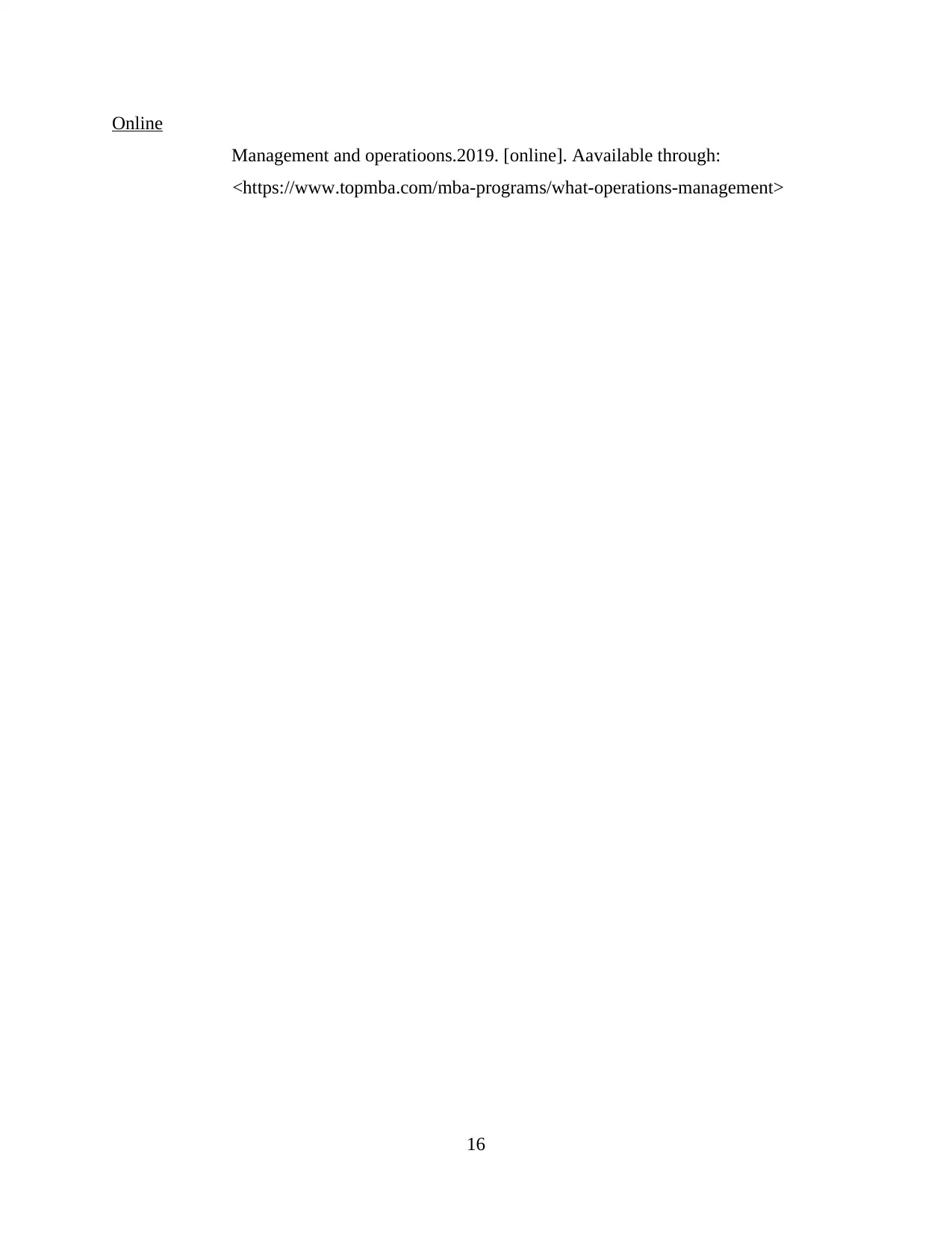
Online
Management and operatioons.2019. [online]. Aavailable through:
<https://www.topmba.com/mba-programs/what-operations-management>
16
Management and operatioons.2019. [online]. Aavailable through:
<https://www.topmba.com/mba-programs/what-operations-management>
16
1 out of 18
Related Documents
Your All-in-One AI-Powered Toolkit for Academic Success.
+13062052269
info@desklib.com
Available 24*7 on WhatsApp / Email
![[object Object]](/_next/static/media/star-bottom.7253800d.svg)
Unlock your academic potential
© 2024 | Zucol Services PVT LTD | All rights reserved.





